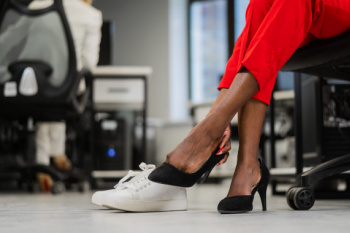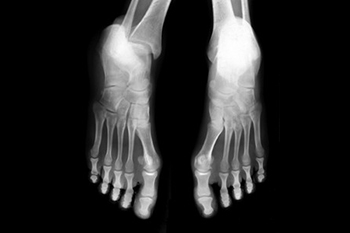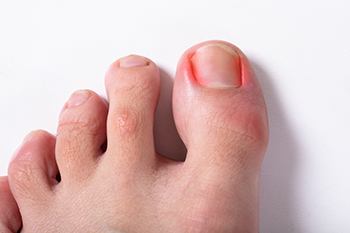Connect With Us
Items filtered by date: January 2024
The Optimal High Heel Height

Choosing the right high heel height is a delicate balance between fashion and comfort, with implications for both style and foot health. While personal preferences play a role, experts recommend considering a heel height that is one to two inches. This range provides a stylish lift without subjecting the feet to excessive pressure or discomfort. Lower heels distribute weight more evenly, reducing strain on the balls of the feet and minimizing the risk of conditions such as bunions or metatarsalgia. Additionally, a modest heel height promotes a more natural posture, preventing issues like lower back pain and Achilles tendon strain. Ultimately, the optimal high heel height is one that allows you to walk with grace and confidence while prioritizing the well-being of your feet. By striking this balance, you can effortlessly blend style with comfort, ensuring your footwear choices enhance both your fashion statement and overall foot health. If you are interested in seeking additional information about how wearing high heels affect your feet, it is suggested that you consult a podiatrist.
High heels have a history of causing foot and ankle problems. If you have any concerns about your feet or ankles, contact Ali Davis, DPM from The Foot Clinic. Our doctor can provide the care you need to keep you pain-free and on your feet.
Effects of High Heels on the Feet
High heels are popular shoes among women because of their many styles and societal appeal. Despite this, high heels can still cause many health problems if worn too frequently.
Which Parts of My Body Will Be Affected by High Heels?
- Ankle Joints
- Achilles Tendon – May shorten and stiffen with prolonged wear
- Balls of the Feet
- Knees – Heels cause the knees to bend constantly, creating stress on them
- Back – They decrease the spine’s ability to absorb shock, which may lead to back pain. The vertebrae of the lower back may compress.
What Kinds of Foot Problems Can Develop from Wearing High Heels?
- Corns
- Calluses
- Hammertoe
- Bunions
- Morton’s Neuroma
- Plantar Fasciitis
How Can I Still Wear High Heels and Maintain Foot Health?
If you want to wear high heeled shoes, make sure that you are not wearing them every day, as this will help prevent long term physical problems. Try wearing thicker heels as opposed to stilettos to distribute weight more evenly across the feet. Always make sure you are wearing the proper shoes for the right occasion, such as sneakers for exercising. If you walk to work, try carrying your heels with you and changing into them once you arrive at work. Adding inserts to your heels can help cushion your feet and absorb shock. Full foot inserts or metatarsal pads are available.
If you have any questions please feel free to contact our office located in Overland Park, KS . We offer the newest diagnostic and treatment technologies for all your foot and ankle needs.
Common Running Injuries and Prevention Strategies

Engaging in running offers numerous health benefits, but it also comes with the risk of encountering common injuries that can sideline even the most dedicated runners. One common issue is plantar fasciitis, causing heel pain. This condition is often a result of overuse or improper footwear. Regular stretching and wearing supportive shoes can be preventive measures. Achilles tendinitis, involving inflammation of the Achilles tendon, emphasizes the importance of gradual training increments and proper footwear. Prioritizing rest, cross-training, and incorporating strength exercises into one's routine can significantly reduce the risk of these common running injuries, ensuring a more enjoyable and injury-free running experience. If you are experiencing foot, toe, or ankle injuries related to running, it is suggested that you consult a podiatrist who can recommend effective treatment options.
Exercising your feet regularly with the proper foot wear is a great way to prevent injuries. If you have any concerns about your feet, contact Ali Davis, DPM of The Foot Clinic. Our doctor will treat your foot and ankle needs.
How to Prevent Running Injuries
Many common running injuries are caused by overuse and overtraining. When the back of the kneecap starts wearing out and starts causing pain in your knee, this is commonly referred to as runner’s knee. Runner’s knee is a decrease in strength in your quadriceps and can occur if you’re not wearing properly fitted or supporting shoes. To prevent runner’s knee, focusing on hip strengthening is a good idea, as well as strengthening your quads to keep the kneecaps aligned.
What Are Some Causes of Running Injuries?
- One cause of a common running injury is called iliotibial band syndrome.
- Plantar fasciitis is also another common injury.
- Stress fractures can occur from overtraining, lack of calcium, or even your running style.
Best Ways to Prevent Running Injuries
- Wear footwear that fits properly and suits your running needs.
- Running shoes are the only protective gear that runners have to safeguard them from injury.
- Make a training schedule. Adding strengthening exercises as well as regular stretching can help keep you strong and limber and can lessen the possibility of injuries.
- Stretching keeps muscles limber; this will help you gain better flexibility.
If you have any questions please feel free to contact our office located in Overland Park, KS . We offer the newest diagnostic and treatment technologies for all your foot and ankle needs.
Understanding Foot Stress Fractures

A foot stress fracture, a microscopic crack in a bone, can bring discomfort and disruption to one's daily activities. Typically caused by repetitive stress and overuse, these fractures often occur in weight-bearing bones, such as the metatarsals. These bones often endure more force than they can handle, leading to tiny cracks that, when compounded over time, manifest as stress fractures. Athletes engaging in high-impact activities, dancers, and military personnel are particularly susceptible due to the repetitive nature of their routines. Factors like sudden increases in activity intensity, improper footwear, or inadequate recovery periods can elevate the risk. Early recognition of symptoms such as localized pain, swelling, and tenderness is essential for timely intervention. Adopting preventive measures, such as a gradual increase in activity levels, and incorporating rest into routines can significantly decrease the risk of foot stress fractures. If you have developed a foot stress fracture, it is suggested that you confer with a podiatrist who can offer the treatment method that is right for you.
Activities where too much pressure is put on the feet can cause stress fractures. To learn more, contact Ali Davis, DPM from The Foot Clinic. Our doctor can provide the care you need to keep your pain free and on your feet.
Dealing with Stress Fractures of the Foot and Ankle
Stress fractures occur in the foot and ankle when muscles in these areas weaken from too much or too little use. The feet and ankles then lose support when walking or running from the impact of the ground. Since there is no protection, the bones receive the full impact of each step. Stress on the feet can cause cracks to form in the bones, thus creating stress fractures.
What Are Stress Fractures?
Stress fractures occur frequently in individuals whose daily activities cause great impact on the feet and ankles. Stress factors are most common among:
- Runners
- People affected with Osteoporosis
- Tennis or basketball players
- Gymnasts
- High impact workouts
Symptoms
Pain from the fractures occur in the area of the fractures and can be constant or intermittent. It will often cause sharp or dull pain with swelling and tenderness. Engaging in any kind of activity which involves high impact will aggravate pain.
If you have any questions please feel free to contact our office located in Overland Park, KS . We offer the newest diagnostic and treatment technologies for all your foot and ankle needs.
Facts About Ingrown Toenails

Ingrown toenails occur when the edge or corner of a toenail grows into the adjacent skin, causing pain, redness, and swelling. Although the big toe is commonly affected, any toenail can become ingrown. Various factors contribute to ingrown toenails, including wearing ill-fitting shoes, improper toenail trimming, injuries, and inherent deformities. If the area becomes infected, characterized by redness, swelling and pus, it is strongly suggested that you see a podiatrist for immediate treatment. Severe cases of ingrown toenails may necessitate surgical intervention, involving the removal of the ingrown portion of the nail. Ablation, applying a small electrical charge or liquid solution during surgery, may help to prevent future ingrowth. In some cases a portion of the toenail, or the entire toenail may need to be removed. However, if you do not practice good foot care, the problem is more likely to reoccur. If you have surgery, it can take two to four months for your nail to grow back. Seeking a professional diagnosis is beneficial for those with recurring ingrown toenails or individuals with diabetes. Wearing comfortable shoes aids healing, but persistent or worsening symptoms require medical attention. To safely manage problematic ingrown toenails, it is suggested that you schedule an appointment with a podiatrist.
Ingrown toenails may initially present themselves as a minor discomfort, but they may progress into an infection in the skin without proper treatment. For more information about ingrown toenails, contact Ali Davis, DPM of The Foot Clinic. Our doctor can provide the care you need to keep you pain-free and on your feet.
Ingrown Toenails
Ingrown toenails are caused when the corner or side of a toenail grows into the soft flesh surrounding it. They often result in redness, swelling, pain, and in some cases, infection. This condition typically affects the big toe and may recur if it is not treated properly.
Causes
- Improper toenail trimming
- Genetics
- Improper shoe fitting
- Injury from pedicures or nail picking
- Abnormal gait
- Poor hygiene
You are more likely to develop an ingrown toenail if you are obese, have diabetes, arthritis, or have any fungal infection in your nails. Additionally, people who have foot or toe deformities are at a higher risk of developing an ingrown toenail.
Symptoms
Some symptoms of ingrown toenails are redness, swelling, and pain. In rare cases, there may be a yellowish drainage coming from the nail.
Treatment
Ignoring an ingrown toenail can have serious complications. Infections of the nail border can progress to a deeper soft-tissue infection, which can then turn into a bone infection. You should always speak with your podiatrist if you suspect you have an ingrown toenail, especially if you have diabetes or poor circulation.
If you have any questions, please feel free to contact our office located in Overland Park, KS . We offer the newest diagnostic and treatment technologies for all your foot care needs.
Plantar Warts Can Be Treated!
Defining and Diagnosing Foot Fractures

A foot fracture, also known as a broken foot, refers to the break or crack in one or more of the bones within the foot. These fractures can result from various incidents, such as traumatic injuries, repetitive stress, or weakened bone structure. Diagnosing a foot fracture often involves a combination of physical examination and diagnostic imaging. The podiatrist will assess the injured area, looking for signs like pain, tenderness, swelling, deformity, and impaired range of motion. X-rays are the most common imaging tool used to confirm the diagnosis, allowing podiatrists to determine the type and location of the fracture accurately. Understanding the definition and diagnosis of a foot fracture is crucial for proper treatment and recovery. Whether it is a stress fracture from overuse or a traumatic injury, early diagnosis and appropriate management are essential for optimal healing and the restoration of normal foot function. If you have broken your foot, it is suggested that you consult a podiatrist who can provide one of several treatment options that are right for you.
A broken foot requires immediate medical attention and treatment. If you need your feet checked, contact Ali Davis, DPM from The Foot Clinic. Our doctor can provide the care you need to keep you pain-free and on your feet.
Broken Foot Causes, Symptoms, and Treatment
A broken foot is caused by one of the bones in the foot typically breaking when bended, crushed, or stretched beyond its natural capabilities. Usually the location of the fracture indicates how the break occurred, whether it was through an object, fall, or any other type of injury.
Common Symptoms of Broken Feet:
- Bruising
- Pain
- Redness
- Swelling
- Blue in color
- Numbness
- Cold
- Misshapen
- Cuts
- Deformities
Those that suspect they have a broken foot shoot seek urgent medical attention where a medical professional could diagnose the severity.
Treatment for broken bones varies depending on the cause, severity and location. Some will require the use of splints, casts or crutches while others could even involve surgery to repair the broken bones. Personal care includes the use of ice and keeping the foot stabilized and elevated.
If you have any questions please feel free to contact our office located in Overland Park, KS . We offer the newest diagnostic and treatment technologies for all your foot and ankle needs.
Blog Archives
- April 2025
- March 2025
- February 2025
- January 2025
- December 2024
- November 2024
- October 2024
- September 2024
- August 2024
- July 2024
- June 2024
- May 2024
- April 2024
- March 2024
- February 2024
- January 2024
- December 2023
- November 2023
- October 2023
- September 2023
- August 2023
- July 2023
- June 2023
- May 2023
- April 2023
- March 2023
- February 2023
- January 2023
- December 2022
- November 2022
- October 2022
- September 2022
- August 2022
- July 2022
- June 2022
- May 2022
- April 2022
- March 2022
- February 2022
- January 2022
- December 2021
- November 2021
- October 2021
- September 2021
- August 2021
- July 2021
- June 2021
- May 2021
- April 2021
- March 2021
- February 2021
- January 2021
- December 2020
- November 2020
- October 2020
- September 2020
- August 2020
- July 2020
- June 2020
- May 2020
- April 2020
- March 2020
- February 2020
- January 2020
- December 2019
- November 2019
- October 2019
- September 2019

